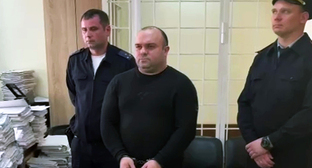23 May 2003, 02:44
Religious traditions of Armenians in Russia
Armenian Apostolic church (AAC) - is one of the most ancient Christian churches. It`s very close to the Orthodox church in its dogmatic and rite traditions. Christianity came to the historical territory of Armenia in the 2-3rd centuries. It became the state religion in the very beginning of the 4th century (in the year 301). Exactly in the same year a temple was built in Echmiadzin (near Yerevan), later it became a cathedral. Now it`s the administrative and ecclesiastical center of the AAC with an Ecclesiastical academy and a seminary. At the moment the head of the church is the Supreme Patriarch and the Catholikos of all Armenians Garegin II.
Until the middle of the 5th century the AAC was one of the branches of United Christian church. Trying to get independent from Byzantium, it got separated from both the Eastern and the Western churches.
Armenians are monophyzites. This trend appeared in Byzantium in the 5th century, it proclaims the indivisible divine nature of Christ. Armenians are one of the most disperse, scattered nations in the world.
The history of the biggest Armenian diaspora in Russia is over two hundred years old. In 1779 on the order of Catherine II there was organized a mass migration of the Christian population of the Crimean Khanate to the southern districts of Russia. Those were mainly Greeks (18 407 people) and Armenians (12 598 people). The purpose of this action was to weaken the Khanate (in 1783 its territory joined the Russian Empire) and to populate the steppes in the south of Russia with people experienced in agriculture, trade and trades. According to the royal order Armenian settlers were given 86 thousand dessiatinas (1 dessiatina= 2 ? acres) of land in the mouth of the river Don near the fortress of St. Dmitry Rostovsky and were allowed to found one city and five villages. The settlers were granted some privileges, they were tax-free for 10 years and didn`t have to join the army for 100 years, they were allowed to build churches where the church ceremonies are conducted according to their laws and traditions, free trade was allowed inside and outside Russia; Armenians were allowed to build factories, plants, trading ships.
At modern times the migration of Armenians to Russia increased after the events in Azerbaijan that were tragic for Armenians and after an earthquake in Armenia in 1988. During this period the number of Armenians in Russia increased many times : according to the census of 1989 there were 532 thousand Armenians living in Russia, in 1993 this number reached 1,5 million.
Armenians happened to be scattered all around the world, under these circumstances Armenian church has a special role in the development of their spiritual and ethnic conscience. Nowadays Armenian prayer houses were opened in some places like Krasnodar, Sochi, Adler; in Adler and Shauman village they received land plots to build churches. In many big cities in the south of Russia land plots were given by the local authorities to build Armenian churches (on the inquiry of Armenian Societies). Armenian cultural societies do a lot of charity for refugees, orphanages, poor members of the community. Armenian church communities are registered in more than 10 cities of the Krasnodar territory. This territory has the biggest number of Armenians among the regions of Russia. They live in Armavir, Krasnodar, Novorossiysk, Adler, Sochi, Armenian village Gaikadzor. In Rostov district there is a cemetery church and the building of the monastery temple Surb Khach. In this building the museum of Russian-Armenian friendship is located. The churches are active in the Armenian villages of the Don.
27 communities of the AAC are registered on the territory of Russia, they are part of Novo-Nakhichevan and Russian eparchy with a center in Moscow. Its head is the patriarchal Ekzarkh archbishop Tiran Kuregyan.





Комментирование через Кавказский узел